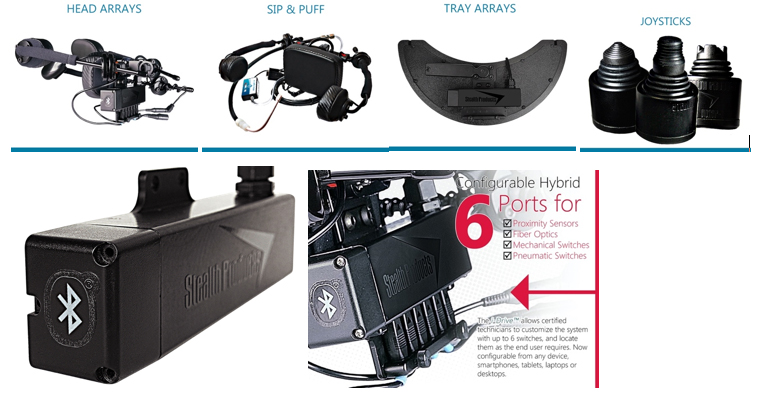Pride Learning Institute
Clinical Adaptability and Versatility of i-Drive Alternative Control System
By: Heather Price, OTR, ATP/SMS, Stealth Products Regional Manager – Central South Region
When people think of the Stealth Products® i-Drive® System, often an image of a head array is what comes to mind. While the head array is one option in the i-Drive product line, it also supports many other alternative drive control options.
What is i-Drive?
The Stealth Products® i-Drive is a central processing unit or CPU. It can process inputs from various switches (proximity, mechanical, pneumatic, and fiber optics) and then output instructions to operate a power wheelchair. Some of the standard configurations available include the head array, head array/sip-n-puff combo, tray array, and the PMPJ mini joystick. In addition to the standard configurations, i-Drive technology allows for hybrid systems, where any type of switch can be used in combination to meet the end user’s needs. There are a total of six ports available on i-Drive to configure a drive control.

Unique Features of i-Drive
There are some unique features that are exclusive to i-Drive. The first is a programming application called the i-Drive Config app, which is available for download on desktops, laptops, tablets, and/or phones. It allows for easy configuration of each port of the i-Drive and corresponding switch. You can connect to the app through a USB or Bluetooth and access configuration to assign commands to each port (e.g., forward, reverse, right, left, mode). Diagnostics lets you verify that your settings function correctly. The technician or clinician configuring i-Drive needs to be registered under the Stealth Products® Dealer Access Directory System (D.A.D.S) in order to log in to the app.

Using Loonz with i-Drive
Next, there is a video game called Loonz that works in combination with i-Drive. It is a driving assessment tool for clinicians and parents that also provides a fun game for children to learn power wheelchair driving skills. Any driver control system that runs through i-Drive is compatible with Loonz (e.g., head array, tray array). Loonz has potential to be set up anywhere, such as a manual wheelchair base, and does not require use of a power wheelchair to use. This is an added benefit, as it provides a safe space for children to practice using an alternative drive control system. It is available for free download on the App Store.

Using Virtual Reality with i-Drive
Another i-Drive driving assessment tool uses virtual reality or VR to provide an immersive experience and the sensation of motion to potential power wheelchair users. Similar to Loonz, the VR can be set up anywhere (does not require the use of a power wheelchair), although it has more broad appeal to adults as well as children. i-Drive connects directly to the VR interface, so any driver control system that runs through i-Drive is compatible with the VR system. The end user then places a headset on and can navigate a power wheelchair through three stages: basic driving in an open environment, outdoor driving and driving in a home environment.

Linked Driving and i-Drive
Lastly, there is a unique programming option called Linked Driving that is available when using i-Drive. This setup allows for two switch sites to offer all four directions of control: a right, left, and forward commands are performed as they would normally be executed through a drive control. For example, the first switch provides a right command, the second provides a left, and when they are activated simultaneously a forward command is engaged. Additionally, through the power wheelchair’s programming, we can activate a reverse command through a toggle when both switches are quickly tapped and released simultaneously (similar to the back pad of a head array). A bonus feature: if using Quantum’s Q-Logic 3 electronics, a double command can be assigned to either switch and voila! You get a mode command. Linked driving setups are commonly used in trays where end users activate switches with their fingers or as switches placed at the outside of the knees for end user with limited UE function & head control. Keep in mind that they can be placed anywhere on the body as long as the switches are easily accessible to the end user.
Clinical Examples of Setups
Let’s consider an end user trialing a head array. They can use the left and right proximity switches imbedded in the pads of the head array, but do not have the head control required to lift their head off of the back switch/pad. We can easily adapt this system by adding a pneumatic switch where the end user can use sip and puff commands to elicit forward and reverse driving. Or, if that doesn’t work, we could try adding the PMPJ mini joystick as a chin drive for forward and reverse.
Another example is an end user who initially uses a head array to operate a power wheelchair. Eventually, their condition progresses, and they lose head control over time although still have motor control of the lower extremities. We can then adapt the i-Drive head array by moving the right and left pads of the head array down to the outside of the knees to allow linked driving.
As you can see, Stealth Products® i-Drive offers more than just a head array. It is an alternative driver control system that is versatile and highly adaptable, allowing for change to maximize the end user’s functional abilities.


